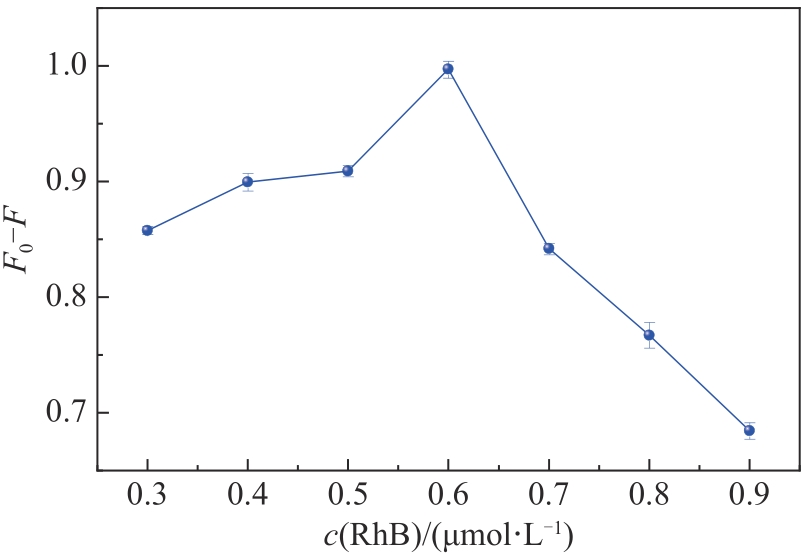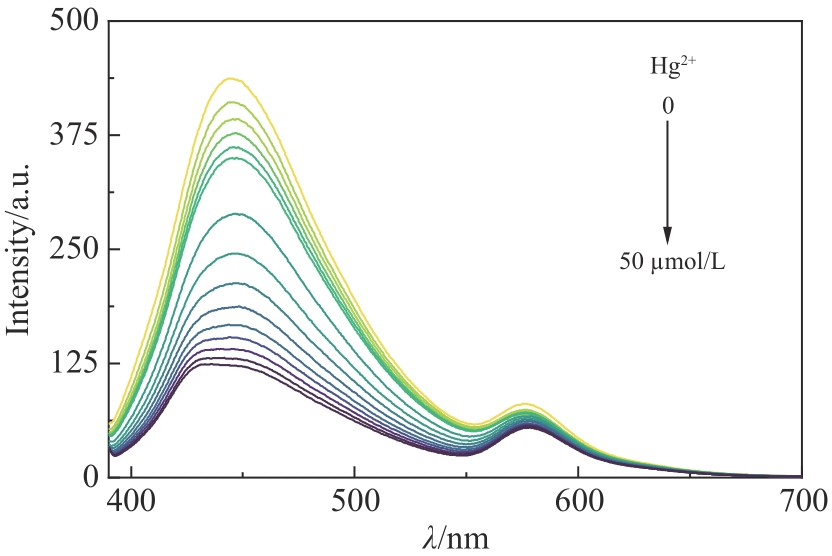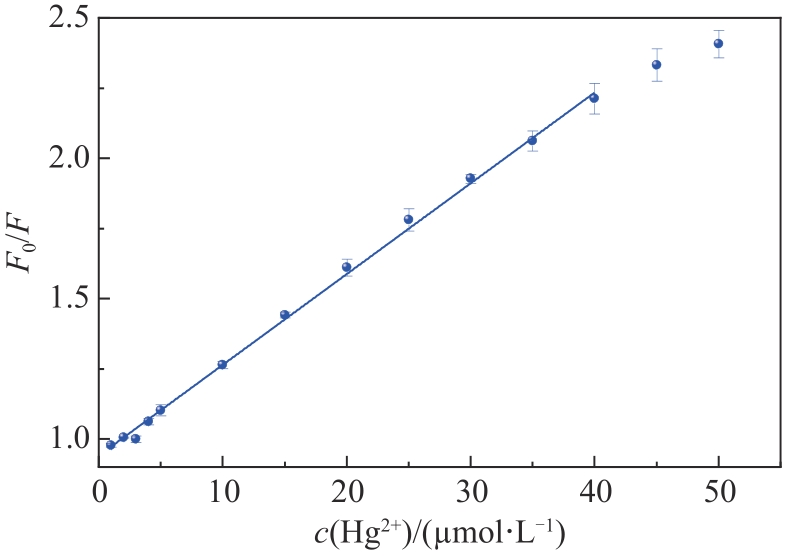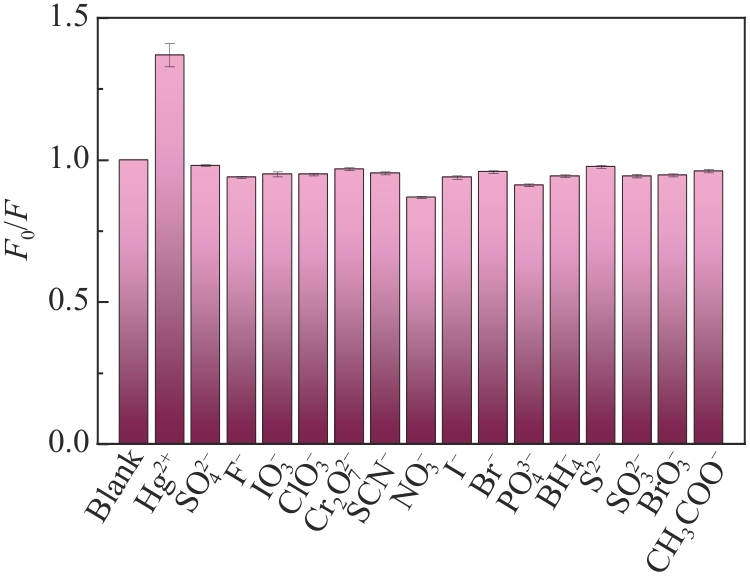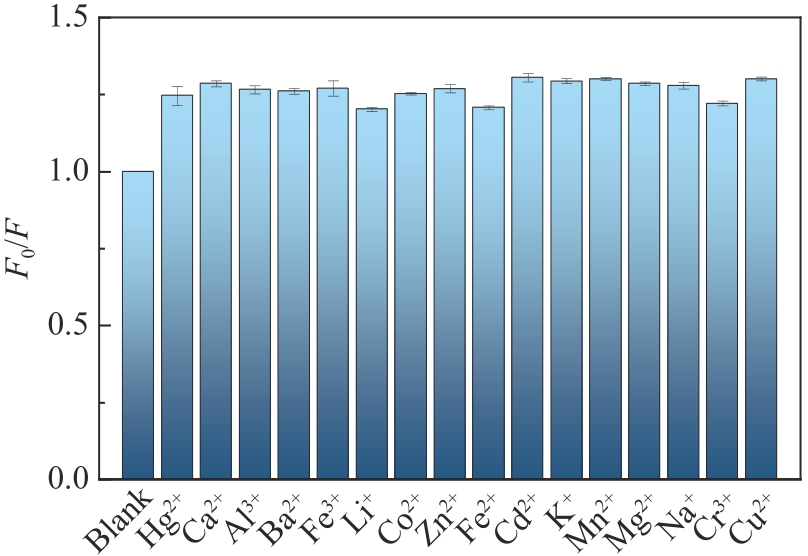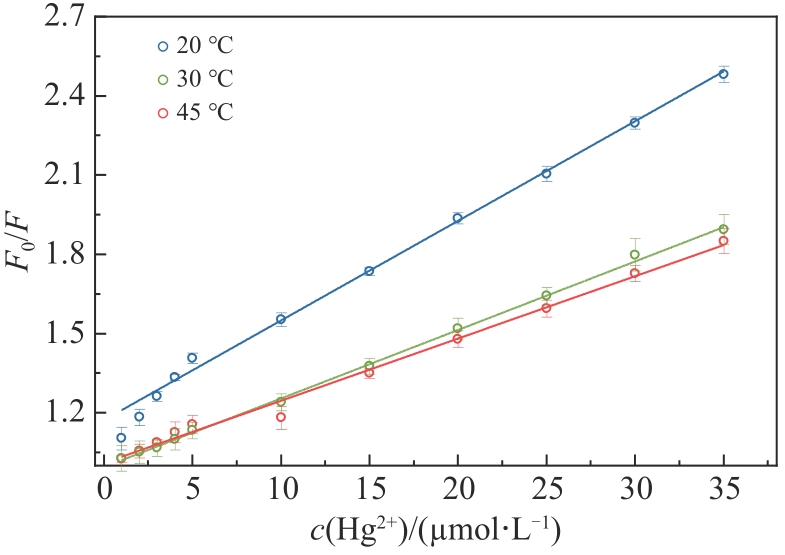
Chinese Journal of Applied Chemistry ›› 2023, Vol. 40 ›› Issue (11): 1550-1557.DOI: 10.19894/j.issn.1000-0518.230166
• Full Papers • Previous Articles Next Articles
Ratio Fluorescence Sensor Based on Carbon Nitride Quantum Dots/Rhodamine B System for Mercury Ion Detection
Ye-Hong ZHOU1, Xu-Yi ZHANG1, Dong-Tao LU1, Hui-Wen XU2, Yang LIU1( ), Chuan DONG1(
), Chuan DONG1( )
)
- 1.Institute for Environmental Science,Shanxi University,Taiyuan 030006,China
2.Taiyuan Heavy Industry Rail Transit Equipment Company Limited,Taiyuan 030032,China
-
Received:2023-06-05Accepted:2023-10-05Published:2023-11-01Online:2023-12-01 -
Contact:Yang LIU,Chuan DONG -
About author:DC@sxu.edu.cn
4747@sxu.edu.cn
-
Supported by:the National Natural Science Foundation of China(22274090)
CLC Number:
Cite this article
Ye-Hong ZHOU, Xu-Yi ZHANG, Dong-Tao LU, Hui-Wen XU, Yang LIU, Chuan DONG. Ratio Fluorescence Sensor Based on Carbon Nitride Quantum Dots/Rhodamine B System for Mercury Ion Detection[J]. Chinese Journal of Applied Chemistry, 2023, 40(11): 1550-1557.
share this article
Add to citation manager EndNote|Ris|BibTeX
URL: http://yyhx.ciac.jl.cn/EN/10.19894/j.issn.1000-0518.230166

Fig.1 (A) TEM image of CNQDs, inset is the HRTEM; (B) XRD spectrum of CNQDs; (C) XPS spectrum of CNQDs; (D) FT-IR spectrum of CNQDs; (E) The absorption, excitation and emission spectra of CNQDs; (F) The excitation dependent fluorescence spectra of CNQDs
| Water samples | Added/(μmol·L-1) | Found/(μmol·L-1) | Recovery/% | RSD/%(n=3) |
|---|---|---|---|---|
| Tap water | 5.00 | 5.29 | 105.8 | 4.8 |
| 10.00 | 10.12 | 101.2 | 3.3 | |
| 35.00 | 35.91 | 102.6 | 1.5 | |
| Lake | 5.00 | 5.91 | 110.2 | 6.8 |
| 10.00 | 11.00 | 110 | 4.8 | |
| 35.00 | 34.58 | 98.8 | 1.4 |
Table 1 The detection ability of CNQDs/RhB ratio fluorescent probes for Hg2+ in water samples
| Water samples | Added/(μmol·L-1) | Found/(μmol·L-1) | Recovery/% | RSD/%(n=3) |
|---|---|---|---|---|
| Tap water | 5.00 | 5.29 | 105.8 | 4.8 |
| 10.00 | 10.12 | 101.2 | 3.3 | |
| 35.00 | 35.91 | 102.6 | 1.5 | |
| Lake | 5.00 | 5.91 | 110.2 | 6.8 |
| 10.00 | 11.00 | 110 | 4.8 | |
| 35.00 | 34.58 | 98.8 | 1.4 |
| 1 | POMAL N C, BHATT K D, MODI K M, et al. Functionalized silver nanoparticles as colorimetric and fluorimetric sensor for environmentally toxic mercury ions: an overview[J]. J Fluorescence, 2021, 31(3): 635-649. |
| 2 | RÍOS M C, BRAVO N F, SÁNCHEZ C C, et al. Chemosensors based on N-heterocyclic dyes: advances in sensing highly toxic ions such as CN- and Hg2+[J]. RSC Adv, 2021, 11(54): 34206-34234. |
| 3 | ZHANG L, WANG Y, HUANG J, et al. Azido chelating fiber: synthesis, characterization and adsorption performances towards Hg2+ and Pb2+ from water[J]. Polym Adv Technol, 2017, 28(11): 1418-1427. |
| 4 | FITRI Z, ADLIM M, SURBAKTI M S, et al. Mercury(II) ions assessment as a toxic waste hazard in solution based on imagery data for a part of environmental disaster management; proceedings of the IOP Conference Series: Earth and Environmental Science, F, 2019[C]. IOP Publishing. |
| 5 | HASSAN A M, AHMED H M, ABOUL-ENEIN H Y. New simple ion-selective membrane electrode for serious environmental pollutant, mercury(II), analysis in aqueous solution, fluorescent mercury lamp white dust, mercurochrome and dental alloy[J]. Curr Anal Chem, 2018, 14(1): 36-42. |
| 6 | SONG S, LI Y, LIU Q S, et al. Interaction of mercury ion (Hg2+) with blood and cytotoxicity attenuation by serum albumin binding[J]. J Hazard Mater, 2021, 412: 125158. |
| 7 | HE L, LU Y, WANG F, et al. Bare eye detection of Hg(II) ions based on enzyme inhibition and using mercaptoethanol as a reagent to improve selectivity[J]. Microchim Acta, 2018, 185(3): 1-8. |
| 8 | SERAFIMOVSKI I, KARADJOVA I, STAFILOV T, et al. Determination of inorganic and methylmercury in fish by cold vapor atomic absorption spectrometry and inductively coupled plasma atomic emission spectrometry[J]. Microchem J, 2008, 89(1): 42-47. |
| 9 | LIU P, PTACEK C J, BLOWES D W, et al. Mechanisms of mercury removal by biochars produced from different feedstocks determined using X-ray absorption spectroscopy[J]. J Hazard Mater, 2016, 308: 233-242. |
| 10 | DOMANICO F, FORTE G, MAJORANI C, et al. Determination of mercury in hair: comparison between gold amalgamation-atomic absorption spectrometry and mass spectrometry[J]. J Trace Elements Med Biol, 2017, 43: 3-8. |
| 11 | THIRUMALAI M, KUMAR S N, PRABHAKARAN D, et al. Dynamically modified C18 silica monolithic column for the rapid determinations of lead, cadmium and mercury ions by reversed-phase high-performance liquid chromatography[J]. J Chromatogr A, 2018, 1569: 62-69. |
| 12 | LIMA A F, DA COSTA M C, FERREIRA D C, et al. Fast ultrasound-assisted treatment of inorganic fertilizers for mercury determination by atomic absorption spectrometry and microwave-induced plasma spectrometry with the aid of the cold-vapor technique[J]. Microchem J, 2015, 118: 40-44. |
| 13 | KUMAR A, AHMED N. Indirect approach for CN-detection: development of “naked-eye” Hg2+-induced turn-off fluorescence and turn-on cyanide sensing by the Hg2+ displacement approach[J]. Ind Eng Chem Res, 2017, 56(22): 6358-6368. |
| 14 | CHEN J, GAO Y, HU X, et al. Detection of hydroquinone with a novel fluorescence probe based on the enzymatic reaction of graphite phase carbon nitride quantum dots[J]. Talanta, 2019, 194: 493-500. |
| 15 | ZHANG Q, LIU Y, NIE Y, et al. Wavelength-dependent surface plasmon coupling electrochemiluminescence biosensor based on sulfur-doped carbon nitride quantum dots for K-RAS gene detection[J]. Anal Chem, 2019, 91(21): 13780. |
| 16 | DANG X, ZHAO H, WANG X, et al. Photoelectrochemical aptasensor for sulfadimethoxine using g-C3N4 quantum dots modified with reduced graphene oxide[J]. Microchim Acta, 2018, 185(7): 1-8. |
| 17 | GU S, HSIEH C T, GANDOMI Y A, et al. Microwave growth and tunable photoluminescence of nitrogen-doped graphene and carbon nitride quantum dots[J]. J Mate Chem C, 2019, 7(18): 5468-5476. |
| 18 | LI L, WANG J, XU S, et al. Recent progress in fluorescent probes for metal ion detection[J]. Frontiers Chem, 2022, 10: 875241-875256. |
| 19 | JAKIMIŃSKA A, PAWLICKI M, MACYK W. Photocatalytic transformation of rhodamine B to rhodamine-110-the mechanism revisited[J]. J Photochem Photobiol A, 2022, 433: 114176-83. |
| 20 | CHENG X, LI S, GONG M, et al. Novel ratiometric fluorescent probe based on internal reference and its detection of hydrazine[J]. J Fluoresc, 2022, 32(3): 1135-1141. |
| 21 | HAMD-GHADAREH S, HAMAH-AMEEN B A, SALIMI A, et al. Ratiometric enhanced fluorometric determination and imaging of intracellular microRNA-155 by using carbon dots, gold nanoparticles and rhodamine B for signal amplification[J]. Microchim Acta, 2019, 186(7): 1-12. |
| 22 | TAO H, ZHANG Z, CAO Q, et al. Ratiometric fluorescent sensors for nitrite detection in the environment based on carbon dot/rhodamine B systems[J]. RSC Adv, 2022, 12(20): 12655-12662. |
| 23 | YANG Y, XIAO X, XING X, et al. Rhodamine B assisted graphene quantum dots flourescent sensor system for sensitive recognition of mercury ions[J]. J Lumin, 2019, 207: 273-281. |
| 24 | LI H, ZHANG C, WANG J, et al. Pristine graphic carbon nitride quantum dots for the visualized detection of latent fingerprints[J]. Anal Sci, 2021, 37(11): 1497-1503. |
| 25 | MOUSAVI A, ZARE-DORABEI R, MOSAVI S H. Sensitive detection of tamsulosin hydrochloride based on dual-emission ratiometric fluorescence probe consisting of amine-carbon quantum dots and rhodamine B[J]. Sci Rep, 2021, 11(1): 20805-20815. |
| 26 | LIN L, ZOU C. Kinetic and thermodynamic study of magnetic separable β-cyclodextrin inclusion complex with organic phosphoric acid applied to removal of Hg2+[J]. J Chem Eng Data, 2017, 62(2): 762-772. |
| 27 | LIN S Y, ZHU H, XU W J, et al. A squaraine based fluorescent probe for mercury ion via coordination induced deaggregation signaling[J].Chin Chem Lett, 2014, 25(9): 1291-1295. |
| 28 | HOLLETT G, ROBERTS D S, SEWELL M, et al. Quantum ensembles of silicon nanoparticles: discrimination of static and dynamic photoluminescence quenching processes[J]. J Phys Chem C, 2019, 123(29): 17976-17986. |
| 29 | CIOTTA E, PROSPOSITO P, PIZZOFERRATO R. Positive curvature in Stern-Volmer plot described by a generalized model for static quenching[J]. J Lumin, 2019, 206: 518-522. |
| [1] | Pan YU, Guang-Hui WANG, Jian-Hua GUO, Qiao-Zhi GUO, Chuan DONG. Yellow Fluorescent Carbon Dots for Sensitive Detection of Chlortetracycline Hydrochloride [J]. Chinese Journal of Applied Chemistry, 2023, 40(7): 1017-1023. |
| [2] | Yue-Xia ZHANG, Xiao-Peng FAN, Yu-Juan CAO, Xin-Tong YANG, Zhong-Ping LI, Zhen-Hua YANG, Chuan DONG. Synthesis of Oil-soluble Carbon Quantum Dots by Pyrolysis Method for the Detection of Oxytetracycline [J]. Chinese Journal of Applied Chemistry, 2023, 40(4): 509-517. |
| [3] | Rui-Zhe WANG, Guang-Qi HU, Wei-Hao YE, Chao-Fan HU, Jian-Le ZHUANG, Bing-Fu LEI, Wei LI, Ying-Liang LIU. Hydrothermal Preparation and Application of Oil-soluble Carbon Dots with High Ultraviolet-short-wave Blue Light Shielding [J]. Chinese Journal of Applied Chemistry, 2023, 40(1): 59-68. |
| [4] | Zhen-Hua YANG, Xuan-Sen SUN, Yue-Xia ZHANG, Yu-Juan CAO, Qi-Qi ZHANG, Qiao-Zhi GUO, Xiao-Peng FAN, Zhong-Ping LI, Chuan DONG. Preparation of Nitrogen Sulfur Co⁃doped Carbon Dots with Nitrogen Sulfur and the Application for Detection of Oxytetracycline in Milk [J]. Chinese Journal of Applied Chemistry, 2022, 39(9): 1382-1390. |
| [5] | Lian-Bo TANG, Da-You FU, Qi CHEN, Yang-Run FENG, Ya-Lin XIONG, Zhu-Qing WANG. Enhanced Gas⁃Liquid Chemiluminescence by Carbon Dots for Determination of Carbon Dioxide [J]. Chinese Journal of Applied Chemistry, 2022, 39(8): 1294-1302. |
| [6] | Hai-Yan QI, Chen-Qi ZHANG, Jin-Long LI, Jun LI. Synthesis of Sulfur and Nitrogen Doped Carbon Dots for Cu(Ⅱ) Detection [J]. Chinese Journal of Applied Chemistry, 2022, 39(6): 980-989. |
| [7] | Jin-Ping SONG, Qi MA, Xiao-Min LIANG, Jian-Peng SHANG, Chuan DONG. Neodymium and Nitrogen Co‑doped Carbon Dots with High Fluorescence Quantum Yield for Detection of Sulfasalazine and Hela Cell Imaging [J]. Chinese Journal of Applied Chemistry, 2022, 39(11): 1726-1734. |
| [8] | Dan MENG, Kai-Yuan ZHENG, Shan-Shan CHEN, Zhao-Long ZHUO, Li-Li WANG. Preparation and Luminescence Properties of Silicon and Nitrogen Co⁃doped Carbon Dots Phosphors [J]. Chinese Journal of Applied Chemistry, 2022, 39(11): 1766-1773. |
| [9] | LIU Qiao-Ling, REN Bo-Rong, LIU Rui-Rong, LI Yu-Xia, WANG Gui-Xiang, REN Zi-Wei, DONG Chuan. N-Doped Carbon Dots with Ratio Fluorescent Detection for Ag+ [J]. Chinese Journal of Applied Chemistry, 2021, 38(11): 1512-1520. |
| [10] | HU Guowen, QIAO Yuling. Folic Acid-Carbon Dot Conjugates for Cancer Cell Targeting [J]. Chinese Journal of Applied Chemistry, 2020, 37(9): 1003-1009. |
| [11] | HU Guowen, QIAO Yuling. Folic Acid-Carbon Dot Conjugates for Cancer Cell Targeting [J]. Chinese Journal of Applied Chemistry, 2020, 37(9): 0-0. |
| [12] | XU Liping, LIU Qingshi, DONG Zhichen, GUO Xingjia, DONG Wei. Simple, Fast and Accurate Detection of Ciprofloxacin Based on Fluorescence Enhancement of Nitrogen-Doped Carbon Dots [J]. Chinese Journal of Applied Chemistry, 2020, 37(7): 830-838. |
| [13] | DONG Zhiyun, LIU Yang, WANG Yingjin, ZHAO Sanhu, XI Fugui. Naphthalimide-Benzimidazolium Based Fluorescent Chemosensor for Highly Selective Recogniton of H2PO-4 [J]. Chinese Journal of Applied Chemistry, 2020, 37(7): 839-846. |
| [14] | MENG Yating, JIAO Yuan, ZHANG Yuan, GAO Yifang, LU Wenjing, LIU Yang, DONG Chuan. Synthesis of Red Emission Fluorescent Carbon Dots and Its Application for Detection of Persulfate [J]. Chinese Journal of Applied Chemistry, 2020, 37(6): 719-725. |
| [15] | GONG Hui, KANG Yu, ZHANG Rong, REN Guodong, HOU Xiaoyu, ZHANG Min, LI Lihong, LIU Wen, WANG Haojiang, DIAO Haipeng. Preparation of Nitrogen-Doped Carbon Dots for Highly Sensitive Detection of Amoxicillin [J]. Chinese Journal of Applied Chemistry, 2020, 37(2): 227-234. |
| Viewed | ||||||
|
Full text |
|
|||||
|
Abstract |
|
|||||



